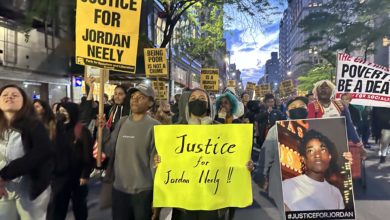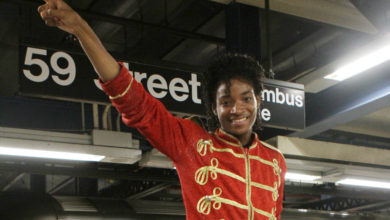A March 20 New York Times article paints a very sobering picture of the reality facing Black males in the United States. The article details several studies focusing on economic and social statistics that have emerged since the 1990s.
 Photo: Bill Hackwell |
“The share of young black men without jobs has climbed relentlessly, with only a slight pause during the economic peak of the late 1990s,” the Times relates. “In 2000, 65 percent of black male high school dropouts in their 20s were jobless—that is, unable to find work, not seeking it or incarcerated. By 2004, the share had grown to 72 percent, compared with 34 percent of white and 19 percent of Hispanic dropouts.
“Even when high school graduates were included,” the article continues, “half of black men in their 20s were jobless in 2004, up from 46 percent in 2000.
“Incarceration rates climbed in the 1990s and reached historic highs in the past few years. In 1995, 16 percent of black men in their 20s who did not attend college were in jail or prison; by 2004, 21 percent were incarcerated. By their mid-30s, six in ten black men who had dropped out of school had spent time in prison.
“In the inner cities, more than half of all black men do not finish high school.”
These statistics reveal a constant feature of U.S. society. The impoverishment of the working class is not uniform, socially or geographically. It is disproportionately concentrated in the nationally oppressed communities in the country—and especially in the African American communities.
Right-wing commentators blame this problem on a supposed lack of personal initiative. They claim that everyone has opportunities and that African Americans should “pull themselves up by their bootstraps,” as if the fault for the super-oppression of Black communities was somehow the result of personal or cultural faults.
But the statistics show that the problem goes far beyond “lack of opportunity.” For example, the studies found that even during the so-called economic peak of the 1990s, it was almost impossible for young Black men to find jobs. “Over the last two decades, the economy did great,” claimed Columbia University professor Ronald Mincy, author of the 2006 study, “Black Males Left Behind.” “But young Black men were falling farther behind.”
Most job growth since the 1980s has been in the service sector, which in general is low paying, using so-called unskilled labor. This has increased the overall gap between rich and poor.
For Black males in the inner city, it is often worse. Unable to get a job, many turn to “hustling” in their neighborhoods in order to get by.
School—vaunted as the “ticket out” of poverty and despair—is rarely a viable option. Inner-city schools are most often in states of horrible disrepair, with outdated textbooks and not enough teachers, causing many students to fall behind early with no chance of catching up.
Add to this the fact that the lack of adequate counseling causes many students with serious learning disabilities to fend for themselves, forever labeled as “problem children.”
There is almost no access in inner city schools to serious college preparation courses or SAT preparatory programs, like Kaplan, that cost thousands of dollars. Access to these types of programs is offered through programs like the federal Upward Bound program, which routinely has seen its funding cut and can accept only a small percentage of students. There are but a few Advanced Placement classes in inner-city high schools that give students a better chance to be admitted to college.
Capitalism is the disease
The social workers and professors quoted in the article call for more money for social programs, job training and “life training.” What none of them do—what none of them can do within the limits of bourgeois academia or ideology—is acknowledge that the statistics they relate are a symptom of the normal functioning of U.S. capitalism.
The desperate conditions facing the vast majority of the Black population are a direct result of the four centuries of slavery—the defining reality that shaped the Black nation in the United States.
They are a direct result of the Ku Klux Klan terror unleashed on the Black population after the Civil War, a terror that is still echoed today in the racist police violence against Black communities in every city in the United States.
They are a direct result of the decades of legal Jim Crow apartheid that kept African Americans “separate and unequal” both in the South and, more insidiously, in the North.
And they are a direct result of the racist policies by successive governments and banking and corporate executives in hiring, funding and social priorities that continue to this day.
In short, the desperate conditions facing the Black nation today—and Black men in particular—are a direct result of the capitalist exploitation of the overwhelmingly working-class African American population, combined with the distinctly racist national oppression of the Black population that has been a permanent feature of U.S. capitalism.
Racism means big profits
National oppression of the Black community under U.S. capitalism has several driving factors. It serves to divide the multinational U.S. working class, infecting the white working class in particular with racist chauvinism to prevent class-consciousness against their common exploiters.
It also serves to extract greater profits from the Black working class, close to 40 million strong. This happens most directly on the job, where wages are lower and benefits fewer than among the working class as a whole.
But it also happens in more insidious ways. One way of extracting greater profits that is relevant to the conditions facing Black men is the prison-industrial complex—the multi-billion-dollar for-profit prison system.
Corporations like IBM, Dell, Macy’s and hundreds of others have contracts with state governments to use prisoners for labor. In addition, prison labor is used directly by the federal government to make all U.S. military uniforms, for example.
Prison business went from $392 million in 1984 to $1.3 billion dollars in 1994. Prisoners are paid no more than $2 an hour in public prisons; in many private prisons, they are making as little as 17 cents an hour.
Ironically, prison labor has again made it profitable for U.S. manufacturers to employ workers in the United States, since the wages are as low as any oppressed country like Mexico or Haiti. The repression of workers that is generally carried out by U.S.-backed dictatorships is now handled directly by prison guards.
In fact, the U.S. Constitution to this day allows for slave labor within the prison system. The 13th Amendment, which abolished chattel slavery in 1865, specifically reads, “Neither slavery nor indentured servitude except as a punishment for a crime … shall exist within the United States.” “Prison is the new kind of slavery,” so often heard in Black communities today, is no exaggeration.
This prison-for-profit system has also been a key component in the skyrocketing incarceration rates, especially for non-violent offenses like petty drug charges. The disparity in sentencing for drug possession, for example between sentences for powder cocaine (more predominant among white users) and for rock cocaine (more predominant among Black users), is another factor in the devastating incarceration rates for Black men.
The statistics reveal the extent to which national oppression under capitalism has devastated the Black community. This devastation will not be addressed by more funds or social programs—as much as they are deserved. It can only be truly addressed in the struggle against capitalist exploitation, including the demand for reparations for the Black nation.
Articles may be reprinted with credit to Socialism and Liberation magazine.






